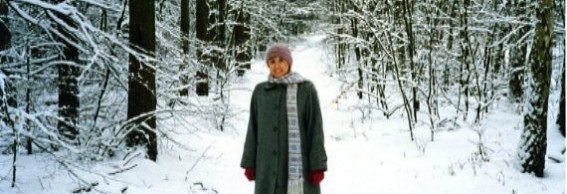Snow Dreams, Dusty Feet: Reflections for Advent
December 2010
(Photo: Arlyne Van Dam Sargent, Christmas Day, Apeldoorn, The Netherlands, 1986)
Growing up in Southern California, I never dreamt of a white Christmas. The best we could hope for was fog. Every few years an early morning cloud layer would seep inland from the coast on Christmas, bringing a small dose of Dickens into suburban Los Angeles. As children, we were even happy for the rain, especially when it flooded the street gutters and allowed us to race the small homemade boats that we occasionally got as gifts.
Only a fraction—usually about 8%—of the world’s people will see the snow fall on Christmas. More often, the holiday is celebrated under balmy skies. Lights are strung over banyan trees in Thailand and along palm-bordered marinas in Singapore. Papai Noel—or Father Christmas—wears silk to survive the Brazilian sun. For many African families living on the Indian Ocean, a white Christmas is a barbeque on the bleached sands of Diani or the Seychelles.
Jesus, for all we know, was born on a sultry night. Many scholars place the birth in late spring or summer, when an evening on the West Bank would be warm enough for shepherds to watch all night in their fields. Even in December, Bethlehem nights are cool but still temperate, perhaps even slightly humid.
I thought of the Christmas sun recently when watching Catherine Hardwicke’s film The Nativity Story. It’s an affectionate retelling of the Luke narrative, oddly framed by comic interludes with the magi, but most notable for its rustic, understated Mary and her long, sweltering journey to Bethlehem.
For me the film carries an extra layer. I first saw it just two days before my father-in-law died, during the last week of Advent four years ago. I had gone to the theatre on task: NPR had asked me to join a conversation about the film with director Hardwicke and Tom Ashbrook, which did air early one morning, just a day before the funeral. At such a time, it was nearly impossible for me not to be drawn to the foreshadowing of suffering and sacrifice that Hardwicke weaves into her tale about the long march to Bethlehem. But, for all the sorrow of that season, I can’t see the film today without also recalling my father-in-law’s easy hospitality on Christmas afternoons, full of spiced eggnog from his dairy or football on his California lawn. Most of all, I remember the Christmas parties when he locked hands with his siblings—all of them Dutch immigrants during the Depression—and sang “Ere Zij God,” or, as it was commonly translated for us, “God is on High.”
The tenderness in Hardwicke’s tale caught many film critics by surprise, especially since her previous work, Thirteen, was a hard-edged descent into adolescent lives filled with drugs, sex, petty crime, and malaise. The Mary of The Nativity Story—not thirteen, but only slightly older—has her own uneasiness, prompted by her betrothal to Joseph, an honorable man, but a stranger chosen by her parents. For the couple, the emotional breakthrough comes beside a riverbank, en route from Nazareth southward, after days of traversing stony hills and arid plateaus. Under the fierce sun—or in a biting sandstorm—Joseph guides Mary on her donkey, his soles continually bruised and cut by the serrated paths. Then, as he dozes by the stream, Mary douses an old cloth and washes his bloody feet.
The scene thrives in its own moment. After days of emotional restraint, Mary touches and soothes this “good and decent man” who will raise her son. But what she cannot know is that she has also presaged the child’s death.
Footwashing is not often associated with Christmas. Most often, it belongs to Maundy Thursday—the night before Good Friday, the last day in Lent, and the commemoration of the hour when Jesus, the servant, knelt with a washbasin before his disciples. Yet if you spend some time unraveling the historical cords you can find links. Advent, after all, originally took its cues from Lent. In the first century after Christ, the forty days of Lent became a season of study and preparation for Easter, when new believers were often baptized together. Over time Christians also adopted another forty-day term of preparation, this one for Epiphany, the Eastern celebration on January 6. Now, our own twenty-seven days of Advent anticipate the Western “mass of Christ” on December 25, even as they also remind us that we still watch for Christ’s return.
To be honest, I am not always sure how to prepare during Advent, so strangely overloaded with shopping, travel and the end-of-semester fury. I do love the candles that begin to fill the December nights, even the electric ones on windowsills that spread across the ice and snow. With all of their hopefulness, though, they also convey a cozy insularity, a house shut up against the dark and the cold and the forlorn. But Advent is equally full of sun-struck moments, with friends, colleagues, neighbors and family members often over-worn by the pressures and anxieties of their own journeys. I can’t tell you how often I have rushed to meet Christmas tasks without stopping to listen, to soothe a dry spirit, simply to wait with the sojourner. In retrospect, of course, I know the gestures and conversations that should have happened. Advent should be the courage to follow through.
I was an adult before I saw my first white Christmas, now more than two decades ago. We were living in the Netherlands at the time, spending Christmas Eve with my father-in-law’s relatives in Apeldoorn, a forested village east of Amsterdam. In the back of the Reformed Church a mahogany pew waits empty, just in case the queen should arrive. There was no royalty present that Christmas Eve, as the congregation, surrounded by candles, sang traditional carols, the melodies familiar to us even as we stumbled through the Dutch words. Then as the service drew to a close the people rose, seemingly without a cue, and with a new solemnity began the refrains of “Ere Zij God.”
I had not anticipated the hymn. It was if I was hearing for the first time the old tune and the heritage of faith that had sustained my in-laws on their own journey through the Depression, eventually ending thousands of miles from their childhood churches and farms. I hear in that anthem now the grand paradox of Christmas: that God was on high, even as he took on humanity in abject poverty, in an occupied, sun-scorched territory, far from his family’s home.
At some point during the service the snow began to fall, striking against the sanctuary windows, whitewashing the cobblestones along the roads and the footpaths through the fields.


 Essays about Gordon
Essays about Gordon


